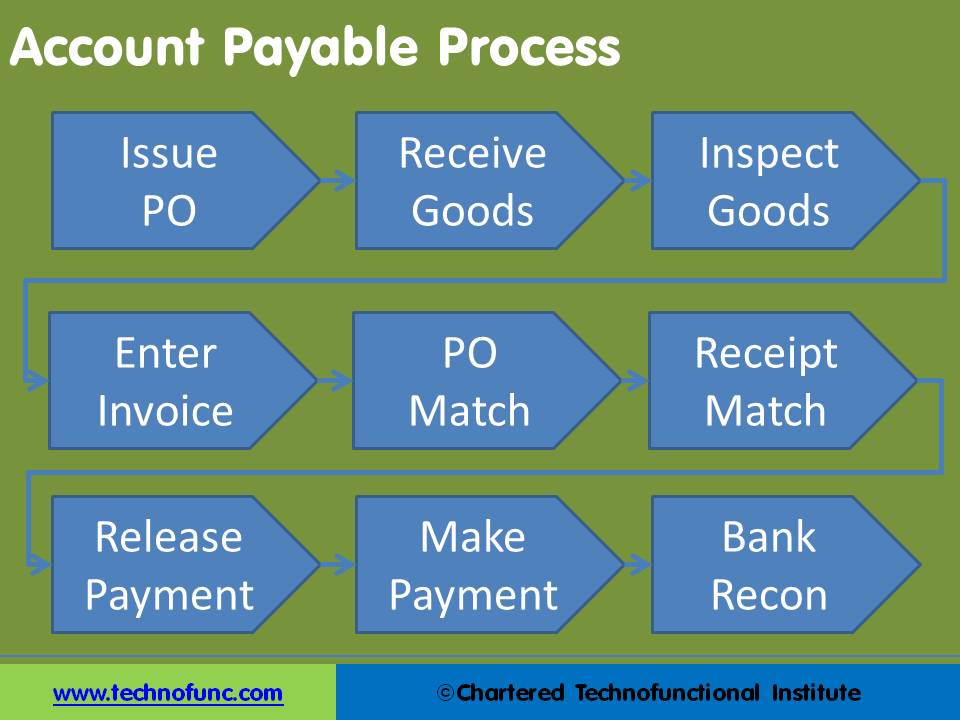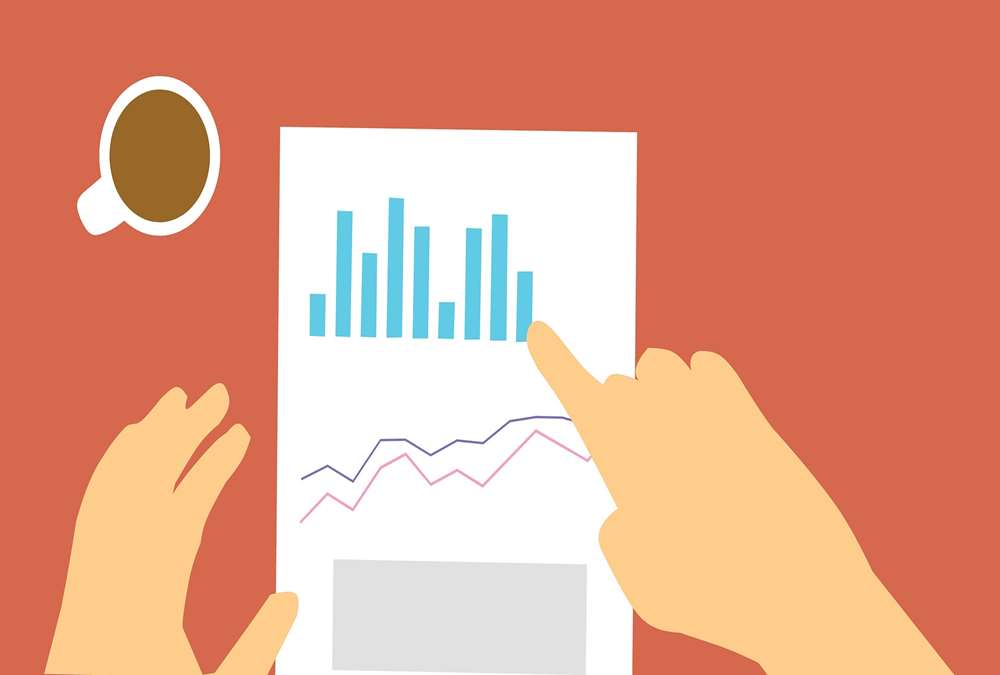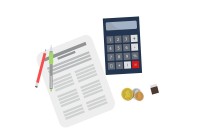- Home
- Business Processes
- Industry Knowledge
- Aerospace Industry
- Automotive Industry
- Banking Domain
- BFSI Industry
- Consumer/ FMCG Industry
- Chemicals Industry
- Engineering & Construction
- Energy Industry
- Education Domain
- Finance Domain
- Hospitality Domain
- Healthcare Industry
- Insurance Domain
- Retail Industry
- Travel and Tourism Domain
- Telecom Industry
- Leadership Skills
- eLearning
- Home
- Business Processes
- Warehouse Management
- Account Payable Process
Account Payable Process
Understand the Accounts Payable process. Understand the AP cycle and the various tasks that need to be completed during AP transaction processing. Learn the key activities and setups that are done in any typical system during the AP processing.
Given below is the complete Accounts Payable Process:
1. Issue Purchase Order:
The AP Process starts with the issue of Purchase order to the Supplier. The purchase order specifies what you intend to buy, the make and the quality of the goods. In some cases it also specifies the agreed quantity and the price.
2. Receive Goods:
Based on the purchase order the supplier will ship a product. Till goods have been received by the customer, the ownership generally lies with the supplier. Once the goods are received at your go down, you become the owner of the goods.
3. Inspect Goods:
Most organizations have the internal control processes to inspect the goods to ensure the quantity and quality of the supplied material.
4. Enter Invoice:
Supplier issues an credit invoice, and collects payment later. This describes a cash conversion cycle, a period of time during which the supplier has already paid for raw materials but hasn't been paid in return by the final customer. Received invoice is accounted for in the books of the customer.
5. PO Match and Receipt Match:
When the invoice is received by the purchaser it is matched to the packing slip and purchase order, and if all is in order, the invoice is paid. This is referred to as the three-way match. The three-way match can slow down the payment process, so three-way matching may be limited solely to large-value invoices, or the matching is automatically approved if the received quantity is within a certain percentage of the amount authorized in the purchase order.
6. Release and Make Payment:
Once the matching is done and accounts payable department is satisfied to the accuracy and validity of purchase, the refer to the payments terms. Companies may have negotiated different payment terms with different suppliers. Payment is released based on the agreed payment terms and amount is issued to the supplier.
7. Bank Reconciliation:
Generally the payment is made through the bank. There is a slight delay between the date when the payment is released and when it reaches to the account of the supplier. The bank entry is reconciled to the original payment entry in the Payments Register to reconcile the both accounts and this completes the account payable process.
In the next video tutorial we will take you through the accounting entries in the payable process.
Given below are some other activities that happen during the AP processing cycle:
- Define and maintain supplier information to be used at the time of invoicing and payment
- Enter invoice information
- Match invoices to Purchase Orders
- Define, enter and import employee expense reports as expenses are also part of payables to employees
- Set up bank accounts for payment to Vendors
- Enter manual payments or use EDI to make automated payments
- Pay invoices
- Stop and void payments in case any holds are required
- Enter and apply prepayments to invoices, adjust advances
- Enter and apply employee advances
- Create recurring invoices for same type of invoices
- Transfer invoices and payment details to General Ledger to ensure proper accounting
- Before any ERP System works, you might need to define the tax defaulting rules and principles

Related Links
You May Also Like
-
Warehouse management and distribution logistics involve the physical warehouse where products are stored, as well as the receipt and movement of goods takes place. Warehouse management aims to control the storage and movement of products and materials within a warehouse. These operations include the receipting of inwards goods, tracking, stacking and stock movement through the warehouse.
-
This article discusses the key documents that gets generated during the import/export process. These documents may apply to both invoice to cash as well as order to cash cycles. Also learn the major custom docments for India.
-
When a customer wants a product that has been stored in the warehouse, the same need to be picked off the shelf (or off the floor) and get it ready for shipping. Depending on how big is the warehouse, picking can take a while. (Many distribution centers cover more than 1 million square feet.). Hence, warehouse order picking methods are an important aspect within any warehouse.
-
This article discusses the documents that gets generated during the procure to pay process. Undestand why these documents are created, what is their business significance and how they are handled and generated using ERP or automated systems.
-
Payables are often categorized as “Trade Payables” & “Expense Payables”. “Trade Payables” are the monies due for the purchase of physical goods that are recorded in Inventory. “Expense Payables” are the monies due for the purchase of goods or services that are expensed.
-
The Outbound process starts with routing the shipments. The Outbound execution process starts from the point when pick tasks are completed for an outbound shipment and ends at the point where the outbound packages are loaded into trailers. The Warehouse Outbound process includes managing and controlling outgoing materials starting from the download of orders through to the shipping of products from the warehouse.
-
Transport operations are often divided into full load and part load and due to economies of scale, the unit costs are higher for part loads. Our customer needs several part loads delivering, so it can reduce costs by consolidating these into full loads. Then it gets all the part loads delivered to a warehouse near the suppliers, consolidates them into full loads, and pays the lower costs of full-load transport to its operations.
-
At a high level, the essential elements in a warehouse are an arrival bay, a storage area, a departure bay, a material handling system and an information management system. As part of the process for enabling a warehouse layout, you must define warehouse zone groups, and zones, location types, and locations.
-
After products have been received and passed a quality inspection, they need to be stored so that you can find them when you need them. This process is called putaway. The spot where you store a particular product is called a location. One section of a warehouse might have small locations for light items; another area may have large locations on the floor for heavy items.
-
We need a strong payables process so that it provides us with a high-productivity accounting solution to process vendor payments. An integrated payables process provides strong financial control so you can prevent duplicate payments, pay for only the goods and services you order and receive, and maximize supplier discounts. Understand the key features of an effective accounts payable system.
Explore Our Free Training Articles or
Sign Up to Start With Our eLearning Courses

About Us
Learning
© 2023 TechnoFunc, All Rights Reserved










